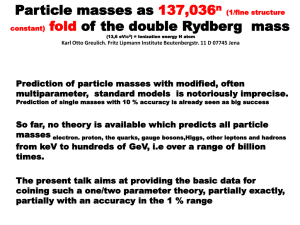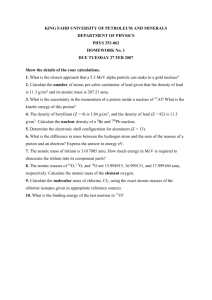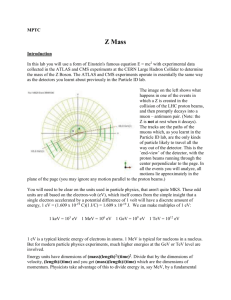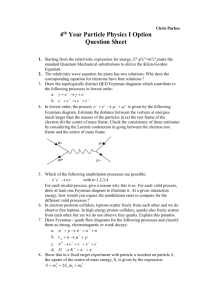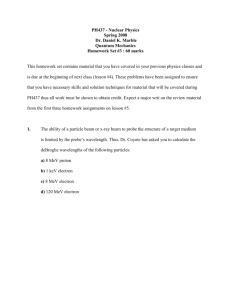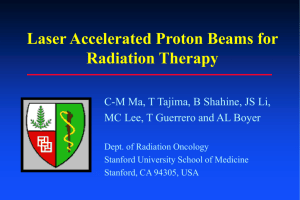Problem Set 2
advertisement
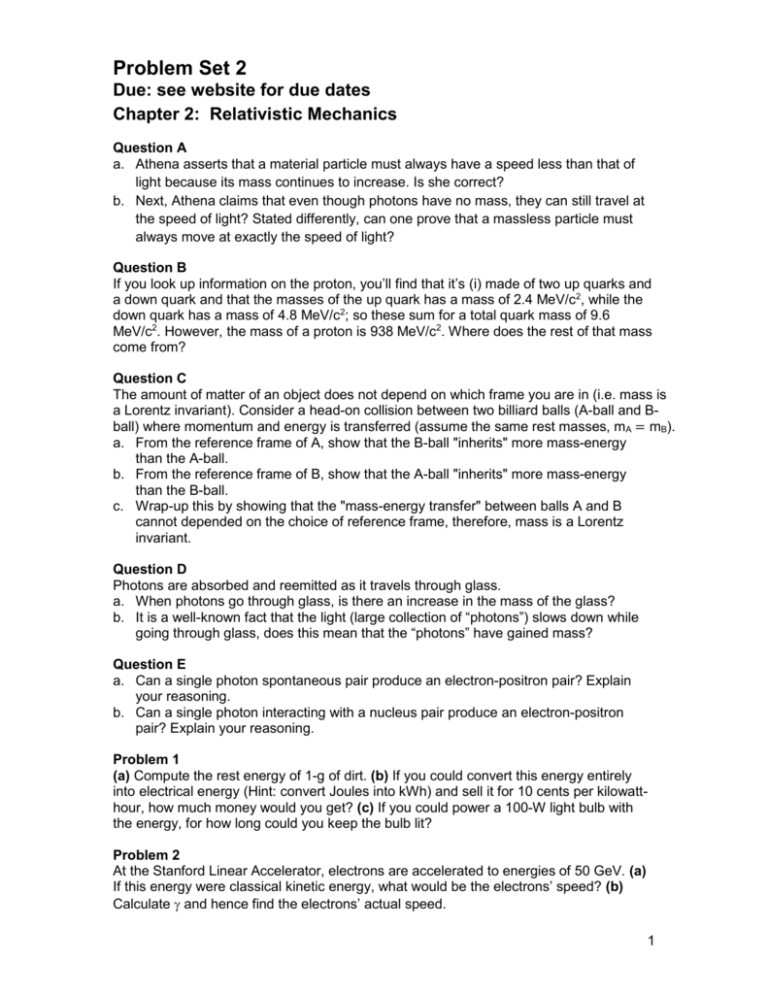
Problem Set 2 Due: see website for due dates Chapter 2: Relativistic Mechanics Question A a. Athena asserts that a material particle must always have a speed less than that of light because its mass continues to increase. Is she correct? b. Next, Athena claims that even though photons have no mass, they can still travel at the speed of light? Stated differently, can one prove that a massless particle must always move at exactly the speed of light? Question B If you look up information on the proton, you’ll find that it’s (i) made of two up quarks and a down quark and that the masses of the up quark has a mass of 2.4 MeV/c2, while the down quark has a mass of 4.8 MeV/c2; so these sum for a total quark mass of 9.6 MeV/c2. However, the mass of a proton is 938 MeV/c2. Where does the rest of that mass come from? Question C The amount of matter of an object does not depend on which frame you are in (i.e. mass is a Lorentz invariant). Consider a head-on collision between two billiard balls (A-ball and Bball) where momentum and energy is transferred (assume the same rest masses, mA = mB). a. From the reference frame of A, show that the B-ball "inherits" more mass-energy than the A-ball. b. From the reference frame of B, show that the A-ball "inherits" more mass-energy than the B-ball. c. Wrap-up this by showing that the "mass-energy transfer" between balls A and B cannot depended on the choice of reference frame, therefore, mass is a Lorentz invariant. Question D Photons are absorbed and reemitted as it travels through glass. a. When photons go through glass, is there an increase in the mass of the glass? b. It is a well-known fact that the light (large collection of “photons”) slows down while going through glass, does this mean that the “photons” have gained mass? Question E a. Can a single photon spontaneous pair produce an electron-positron pair? Explain your reasoning. b. Can a single photon interacting with a nucleus pair produce an electron-positron pair? Explain your reasoning. Problem 1 (a) Compute the rest energy of 1-g of dirt. (b) If you could convert this energy entirely into electrical energy (Hint: convert Joules into kWh) and sell it for 10 cents per kilowatthour, how much money would you get? (c) If you could power a 100-W light bulb with the energy, for how long could you keep the bulb lit? Problem 2 At the Stanford Linear Accelerator, electrons are accelerated to energies of 50 GeV. (a) If this energy were classical kinetic energy, what would be the electrons’ speed? (b) Calculate and hence find the electrons’ actual speed. 1 Problem 3 If an electron and proton (both initially at rest and far apart) come together to form a hydrogen atom, 13.6 eV of energy is released (mostly as light). By how much does the mass of an H atom differ from the sum of the electron and proton masses? What is the fractional difference M/(me + mp)? Problem 4 The K0 meson at rest decays into two charged pions, K0 → + . Use conservation of energy and momentum, to find the energies, momenta and speeds of the two pions. (Give algebraic answer, in terms of the symbols mK and m first; then put in numbers.) [Hint: mK = 498 MeV/c2 and m = 140 MeV/c2] Problem 5 What is the speed of a particle that is observed to have momentum 500 MeV/c and energy 1746 MeV? What is the particle’s mass (in MeV/c2)? Problem 6 A neutral pion traveling along the x axis decays into two photons, one being ejected exactly forward, the other exactly backward. The first photon has three times the energy of the second. Prove that the original pion had speed 0.5c. Problem 7 A particle of unknown mass M decays into two particles of known masses m1 = 0.5 GeV/c2 and m2 = 1 GeV/c2, whole momenta are measured to be p1 = 2.0 GeV/c along the positive y axis and p2 = 1.5 GeV/c along the positive x axis. Find the unknown mass M and its speed. Problem 8 When a beam of high-energy protons collides with protons at rest in the laboratory (e.g., in a container of water or liquid hydrogen), neutral pions () are produced by the reaction p + p p + p + . Compute the threshold energy of the protons in the beam for this reaction to occur. Problem 9 The K0 and the 0 are elementary particles with masses mK and m, respectively. Find the threshold energy for the reaction + p K0 + 0 in the frame of reference in which the proton is at rest. Express your answer in terms of the masses of the particles. Problem 10 a. A pion (0) has a lifetime of 8.4 1017s in its rest frame. In a high-energy collision, a 0 is produced with energy such that the relativistic gamma factor for the particle is 340. How far will the 0 travel before it decays? b. Now suppose that the 0 decays into two massless particles. If one of the particles moves in the same direction that the 0 was moving in, what is the direction of motion of the second one? c. What are the energies of each of the massless particles in terms of the momentum of the original 0? 2





